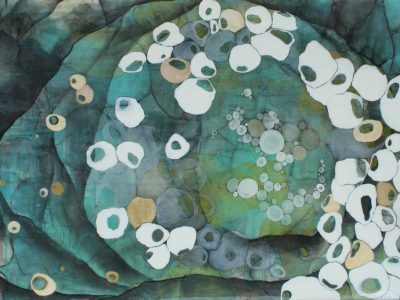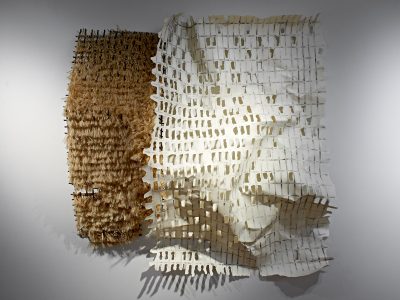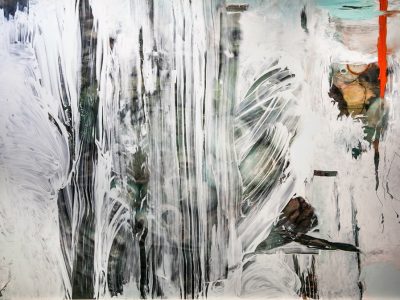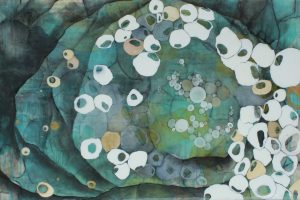- April 28 - June 26, 2015 US/Central
- Wilson Hall second floor
- Fawn Clarke-Peterson
- Jen Evans
- Rita Grendze
Systems and Intuition is a show of paintings, sculpture and constructions by Fawn Clarke-Peterson, Jen Evans and Rita Grendze. These three artists have worked alongside each other in their studios for several years, allowing them to discover unforeseen commonalities in their individual practices.
Fawn Clarke-Peterson
In her work, Fawn Clarke-Peterson explores the tension of edge. This is the place where two states meet, it is where change occurs. For Clarke-Peterson, that tension is full of aesthetic conversation and tactile interest. Simultaneously, material is very important to Clarke-Peterson’s work. Intuition, that is, an openness to the extreme possibilities a particular medium offers, plays a large role in how she allows a work to unfold. Intuitively following her medium’s lead and enticing even humble materials to a context that is rich and evocative is, in her own words, “the most satisfying of collaborations. ” Clarke-Peterson is inspired by the organic and imperfect patterns that occur in nature. Similarly, the jaunty cadence seen in antique manuscripts functions in an imperfect system of symmetry that she finds thrilling. Clarke-Peterson references the flawed regularity of these systems when constructing compounded edges. These edges, are built to confront and compliment one and other.
Jen Evans
Jen Evans drips, carves, pours and scrapes to create complex surfaces that belie her claims to value simplicity. Swirling deep into the picture plane or floating in ever-higher strata, serendipitous forms created by adding and removing layers interlace, sometimes accompanied by angry mark-making or wholesale covering-up, the projection of a maniacal mind seeking in vain to find some peace. Evans doesn’t go far to find visual inspiration, in fact feeling nagged by the pleading nature of her unfiltered observations, distracted by the likes of sidewalk cracks, river bubbles, and accidental compositions found in laundry piles and within door frames. Forms, fields, and sketches swirl in an ever chaotic tornado of ideas and responsibilities, desperate to organize and fall away to reveal one elegant kernel of truth. These paintings and the process of making them are a metaphor for the inner conflict of the overwhelmed modern woman in search of some peace and quiet. Jen Evans lives and works in the Chicago area. Between earning her B.A. and M.A. in Fine Art at Northern Illinois University, she enjoyed the opportunity of living and working in Japan. This experience was a great adventure and has informed her work immeasurably. Her work is inspired by design found in the mundane detritus of the everyday: the colors, textures, and shapes of stones, bubbles, sidewalk cracks, and laundry piles. In addition to painting and teaching, Evans also raises three daughters. She believes this is important to her work as the humility and resourcefulness learned through parenting is reflected and very evident in her large, abstract paintings.
Rita Grendze
The unspoken invitation to touch, smell or listen to Rita Grendze’s artwork is strong. Rhythmic patterns and evidence of labor intensive processes reveal real time passed: yards of sisal cut, frayed and then knotted onto found steel grates, are paired with painstaking drawings of grids that are erased, rumpled and torn. The organic becomes methodical, staged, while the geometric is altered to the point of seeming soft, fabric-like. A thirty foot span of books opening and tumbling out their pages invokes rustling, refers to the feeling of pages ruffled in dry fingers, the smell of a library. A hundred and fifty foot fence made of shovels refers to the tools’ past actions, but also creates a beautiful horizon line with their posture. There is physicality to the artwork that is indicative of its process, reflective of its history, yet indicates a new narrative that has not before been shared. The act of art-making, is finding a way to communicate a solution to a problem. Intuition and logical systems are the two main means by which problems are solved. They are alternate sides of a single coin.








